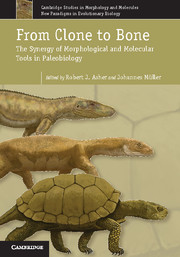Book contents
- Frontmatter
- Contents
- Contributors
- 1 Molecular tools in palaeobiology: divergence and mechanisms
- PART I Divergence
- 2 Genomics and the lost world: palaeontological insights into genome evolution
- 3 Rocking clocks and clocking rocks: a critical look at divergence time estimation in mammals
- 4 Morphological largess: can morphology offer more and be modelled as a stochastic evolutionary process?
- 5 Species selection in the molecular age
- PART II Mechanisms
- 6 Reconstructing the molecular underpinnings of morphological diversification: a case study of the Triassic fish Saurichthys
- 7 A molecular guide to regulation of morphological pattern in the vertebrate dentition and the evolution of dental development
- 8 Molecular biology of the mammalian dentary: insights into how complex skeletal elements can be shaped during development and evolution
- 9 Flexibility and constraint: patterning the axial skeleton in mammals
- 10 Molecular determinants of marsupial limb integration and constraint
- 11 A developmental basis for innovative evolution of the turtle shell
- 12 A molecular–morphological study of a peculiar limb morphology: the development and evolution of the mole's ‘thumb’
- 13 Manus horribilis: the chicken wing skeleton
- Index
- Plate-section
- References
9 - Flexibility and constraint: patterning the axial skeleton in mammals
Published online by Cambridge University Press: 05 November 2012
- Frontmatter
- Contents
- Contributors
- 1 Molecular tools in palaeobiology: divergence and mechanisms
- PART I Divergence
- 2 Genomics and the lost world: palaeontological insights into genome evolution
- 3 Rocking clocks and clocking rocks: a critical look at divergence time estimation in mammals
- 4 Morphological largess: can morphology offer more and be modelled as a stochastic evolutionary process?
- 5 Species selection in the molecular age
- PART II Mechanisms
- 6 Reconstructing the molecular underpinnings of morphological diversification: a case study of the Triassic fish Saurichthys
- 7 A molecular guide to regulation of morphological pattern in the vertebrate dentition and the evolution of dental development
- 8 Molecular biology of the mammalian dentary: insights into how complex skeletal elements can be shaped during development and evolution
- 9 Flexibility and constraint: patterning the axial skeleton in mammals
- 10 Molecular determinants of marsupial limb integration and constraint
- 11 A developmental basis for innovative evolution of the turtle shell
- 12 A molecular–morphological study of a peculiar limb morphology: the development and evolution of the mole's ‘thumb’
- 13 Manus horribilis: the chicken wing skeleton
- Index
- Plate-section
- References
Summary
Introduction
Over the past 200 million years, the mammalian vertebral column has been adapted to the functional demands of animals as diverse as giraffes and bats, giant ground sloths and whales. Despite its impressive morphological and functional adaptability, the column also exhibits unmistakable signs of evolutionary constraint.
The co-existence of flexibility and constraint makes the mammalian vertebral column an intriguing subject for anatomical and evolutionary analysis. Vertebral counts vary from just over 30 to nearly 100 (Flower 1885; Narita and Kuratani 2005), and vertebral lengths from millimetres to tens of centimetres; shape is even more disparate. Yet, the morphological range of the column is limited by the patterning and sequence of its five component subunits (cervical, thoracic, lumbar, sacral, caudal) and by fixed or nearly fixed counts in the cervical and combined thoracolumbar series. Fortunately, the column's accessibility as a subject for study is enhanced by its composition of discrete units that are relatively simple anatomically and easily counted, by the diversity of its adaptations, and by its frequent preservation in the fossil record.
Evolution by natural selection is dependent on both the production of phenotypic variation by the developmental process and by the sorting of that variation by the environment (Raff 1996; Beldade et al. 2002; Brakefield 2006). In simplistic presentation, variation is viewed as the product of a random generating process, with non-random natural selection operating external to the organism. If variation were strictly random, however, evolution should be able to generate almost any morphology, given enough time. But evidence for the existence of bias in the generation of variation has been acknowledged since the early days of evolutionary study, although it was not addressed systematically until William Bateson’s landmark Materials for the Study of Variation (1894).
- Type
- Chapter
- Information
- From Clone to BoneThe Synergy of Morphological and Molecular Tools in Palaeobiology, pp. 230 - 256Publisher: Cambridge University PressPrint publication year: 2012
References
- 13
- Cited by



